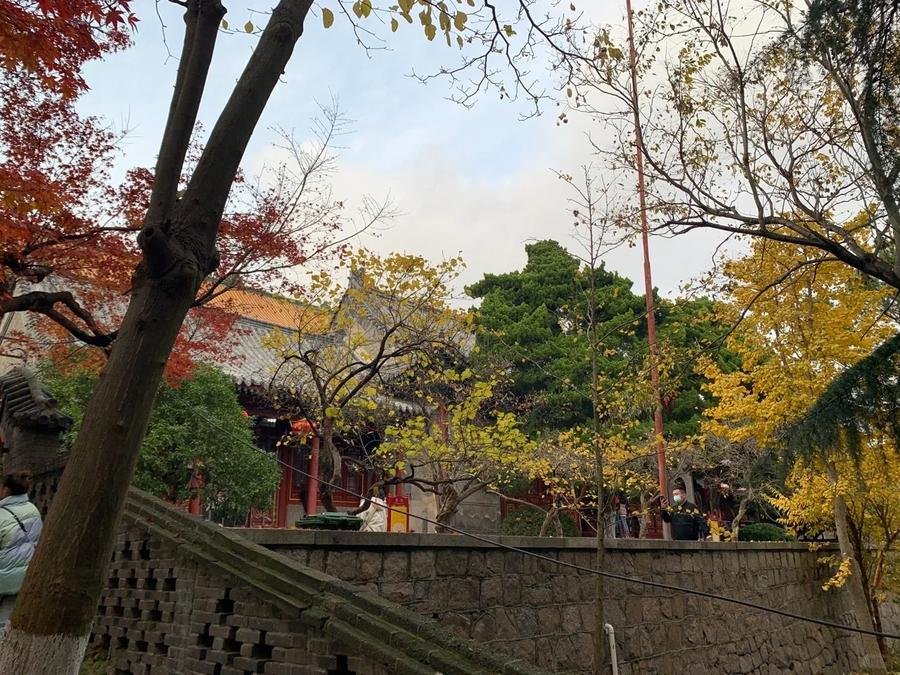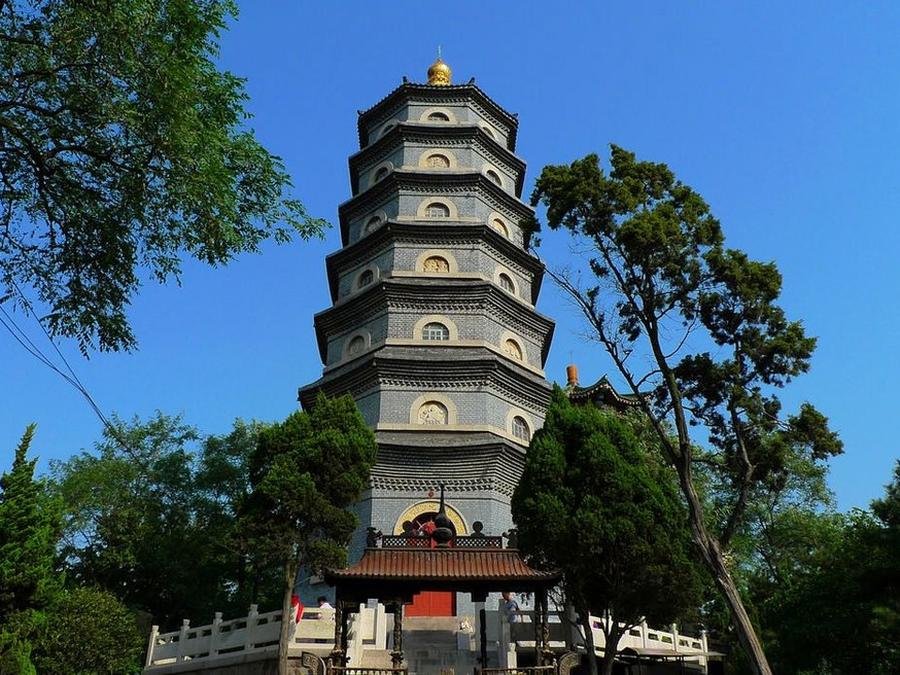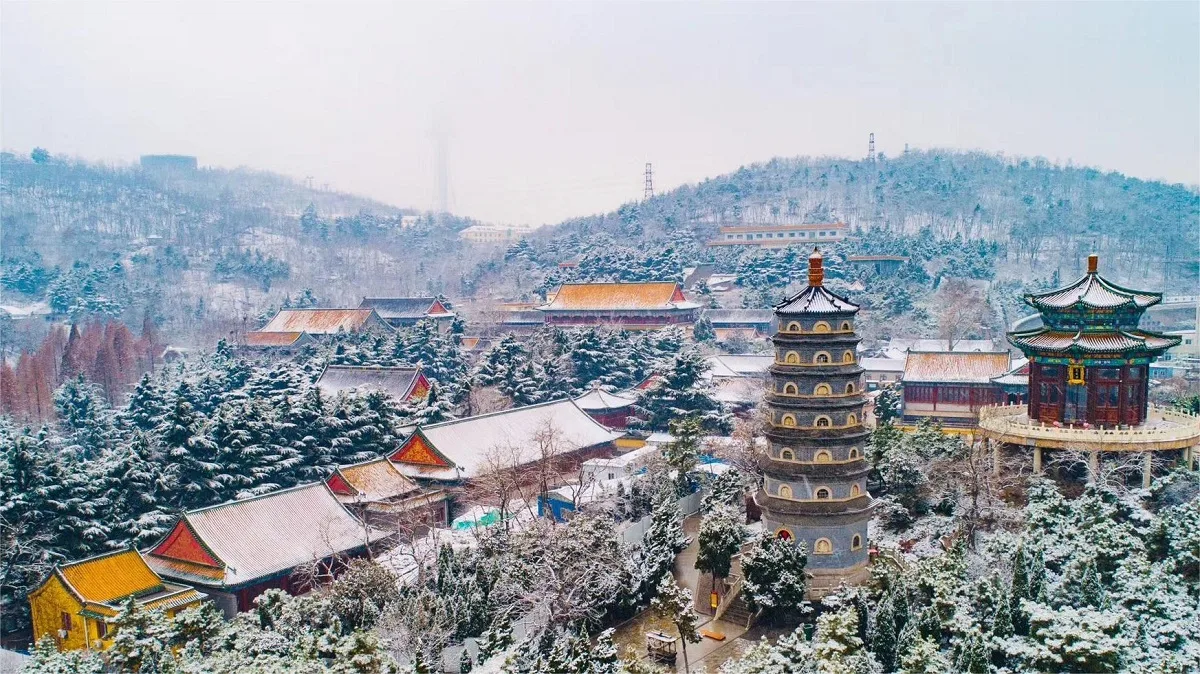Zhanshan Temple (湛山寺, Zhanshansi) is located on the southern slopes of Taiping Mountain in Qingdao, China, and is the only Buddhist temple in the urban area of the city. Construction of the temple began in 1934 and was completed in 1945, with the temple opening to the public in 1986. Covering an area of 53,776.5 square meters and with a building area of 11,053 square meters, Zhanshan Temple is the youngest site of the Tiantai sect of Chinese Buddhism.
When the temple was first established, it aimed to cultivate talent for the propagation of Buddhist teachings, with a focus on the Tiantai school and Pure Land practice. To achieve this, a Buddhist studies supplementary class was initiated, and in 1940, the Qingdao Zhanshan Buddhist School was founded. The temple gained renown both domestically and internationally as many respected and virtuous monks came to teach there.
The architectural complex of Zhanshan Temple follows a traditional Chinese classical temple layout, with buildings aligned along a central axis facing south towards the Yellow Sea. The temple features five courtyards in succession, along with east and west wings and ancillary rooms, comprising a total of 144 halls and rooms. This meticulous and grand design enhances the temple’s serene and spiritual atmosphere, making it a notable destination for both worshippers and tourists.
Table of Contents
- Basic Information
- Location and Transportation
- Highlights of Zhanshan Temple
- Vlog about Zhanshan Temple
- Attractions near Zhanshan Temple
Basic Information
| Estimated Length of Tour | 1 – 2 hours |
| Ticket Price | 10 RMB |
| Opening Hours | 9.00 – 16.00 |
| Telephone Number | 0086-0532-83860702 |
Location and Transportation
Zhanshan Temple is located at No. 2 Zhishan Road, in the Shinan District of Qingdao, Shandong Province. It is situated on the southern slope of Taiping Mountain. To get there, you can choose one of the following ways:
Bus: Take bus 206 Loop Line, 310, 370, or 604 Loop Line, and get off at Zhanshan Temple Stop (湛山寺站).
Metro: The closest metro station to Zhanshan Temple is Zhiquan Road (芝泉路) on line 2. After getting out of the station from Exit C, walk about 450 meters to the west to reach the temple.
Highlights of Zhanshan Temple
The Mahavira Hall

The centerpiece of Zhanshan Temple is the Mahavira Hall, located in the third courtyard, behind the Hall of Heavenly Kings. It stands prominently on a granite base, with five bays in width and four in depth. This hall is where monks gather for morning and evening chants, as well as for important ceremonies and rituals. The courtyard of the Mahavira Hall is spacious, flanked by verdant pine trees and paved with stone slabs, creating a serene and solemn atmosphere.
Inside the Mahavira Hall, the main deities worshipped are Shakyamuni Buddha, Manjushri Bodhisattva, and Samantabhadra Bodhisattva. Additionally, the hall houses statues of the 16 Arhats on the sides, with an image of the Sea Island Guanyin (Avalokiteshvara) at the back. This arrangement reflects the hall’s significant role in spiritual practice and worship within the temple.
The Hall of the Three Saints

Another significant structure in Zhanshan Temple is the Hall of the Three Saints. The stone courtyard in front of this hall is broad and expansive, enhancing the grandeur and solemnity of the building. Inside, the main deities are Amitabha Buddha, Guanyin (Avalokiteshvara) Bodhisattva, and Mahasthamaprapta Bodhisattva. Additionally, there is a statue of Ksitigarbha Bodhisattva at the back of the hall, and the Merit Hall flanks the sides.
A prominent plaque with the inscription “海印遗风 (Sea Seal Legacy)” hangs above the entrance of the Hall of the Three Saints. This inscription has a historical significance tied to the Ming Dynasty monk, Master Hanshan. Hanshan built the Sea Seal Temple near the Naluoyan Cave in Laoshan, but he was later exiled, and the Sea Seal Temple was destroyed, leading to a cessation of Buddhist activities in the region. Three hundred years later, Lay Buddhist Tanxu, who was believed to be a reincarnation of Hanshan, helped to establish Zhanshan Temple, and the “Sea Seal Legacy” plaque was hung to commemorate this historical connection.
Sutra Library

Located behind the Hall of the Three Saints, the Sutra Library is a classical two-story pavilion with a distinctive design and robust fireproofing. The library houses the Qianlong Edition of the Great Buddhist Canon, a monumental collection of 7,240 volumes in 724 cases, encompassing 1,675 Buddhist texts. This edition is one of the most significant official woodblock-printed Buddhist canons in Chinese history. Additionally, the library holds a Hong Kong version of the Great Buddhist Canon Supplement, consisting of 151 exquisitely bound volumes, which serve as a continuation of the main canon.
Medicine Buddha Pagoda

Situated on a hill to the southeast of Zhanshan Temple, the Medicine Buddha Pagoda, formally known as the Medicine Master Lapis Lazuli Light Tathagata Pagoda, is a striking seven-story brick structure with an octagonal base, standing 28.31 meters high. The exterior of the pagoda is adorned with over 100 stone statues of seated Buddhas. Surrounding the base of the pagoda are 28 stone-carved statues of guardian deities, each with unique expressions and postures, adding to the pagoda’s spiritual and artistic significance.







